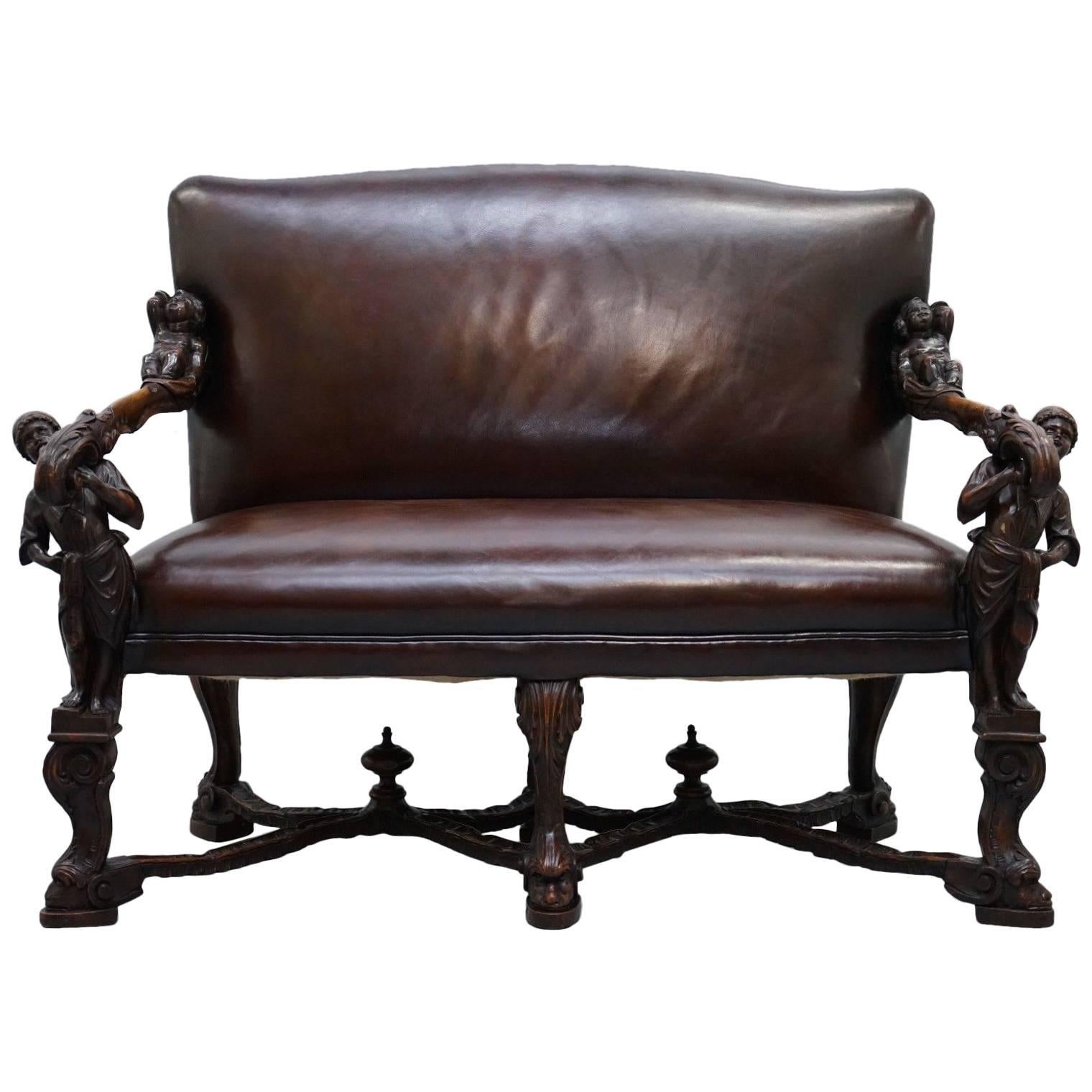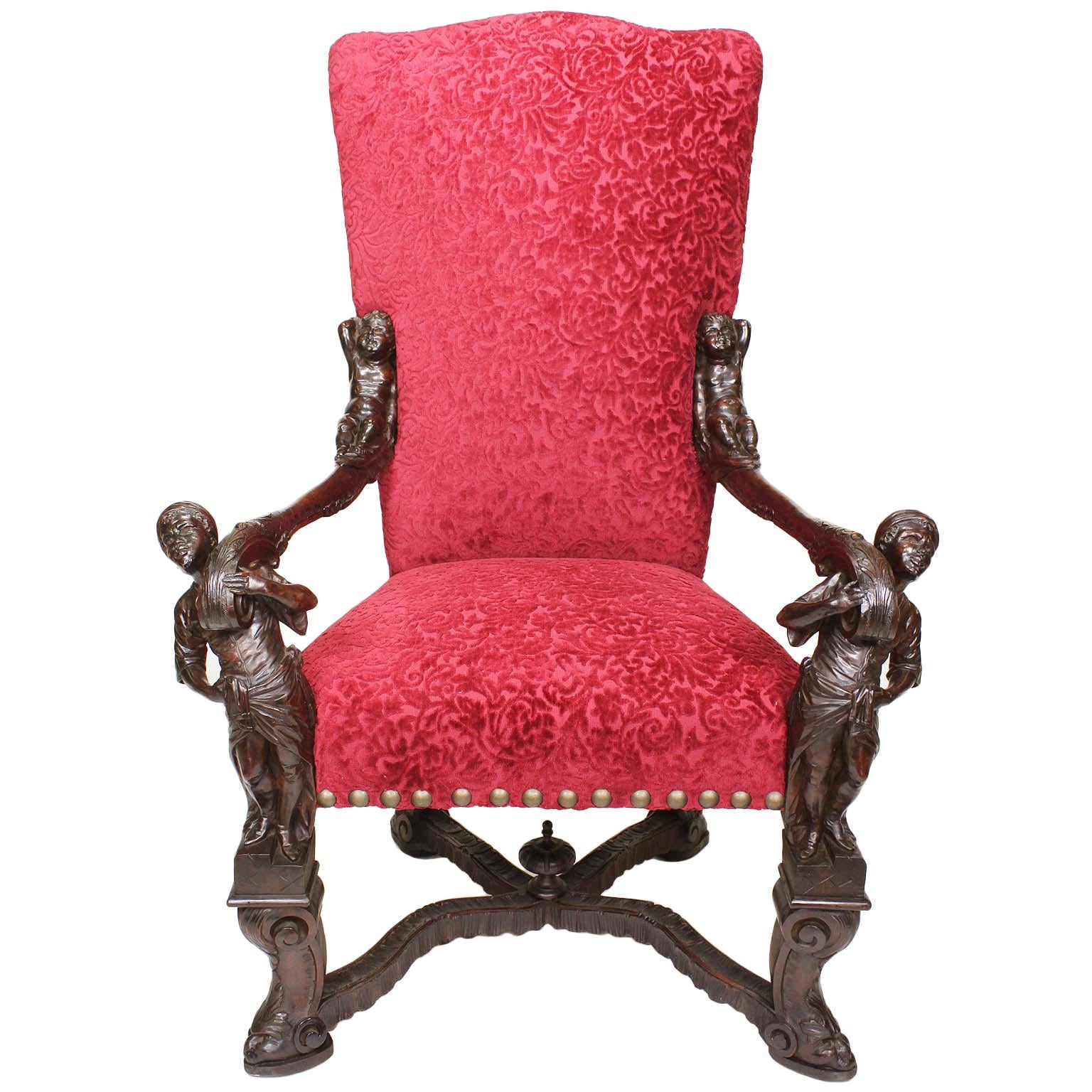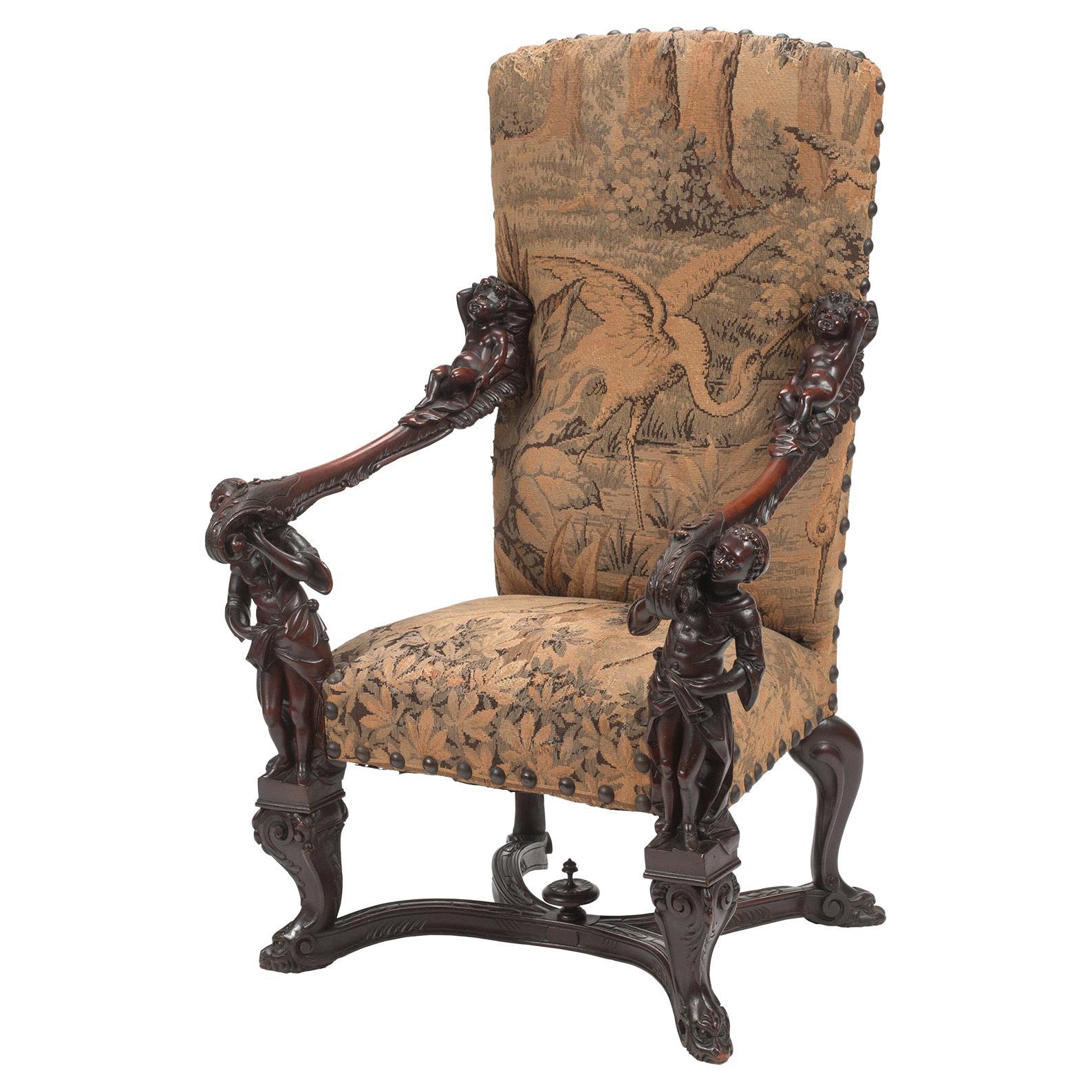Items Similar to In Manner of Andrea Brustolon Venetian 19th Century Carved Walnut Figural Settee
Want more images or videos?
Request additional images or videos from the seller
1 of 20
In Manner of Andrea Brustolon Venetian 19th Century Carved Walnut Figural Settee
About the Item
A fine and rare Italian 19th century Baroque style carved walnut figural settee (Sofa-Loveseat), attributed to Valentino Panciera Besarel (Venice, 1829-1902) in the manner of Andrea Brustolon (1662-1732). The ornately carved frame flanked on each side by Venetian male figures, each supporting an armrest, the top of the foliate armrest carved with a figure of resting Putto, raised on six cabriolet legs with carvings of male masks, all conjoined with X stretchers topped with finials. Upholstered in a recent red-burgundy damask, Venice, circa 1870.
Height: 53 1/8 inches (134.9 cm)
Width: 64 1/2 inches (163.8 cm)
Depth: 29 3/4 inches (75.6 cm)
Seat height: 22 inches (55.9 cm).
Biography
He was trained in a vigorous local tradition of sculpture in his native Belluno, in the Venetian terraferma, and in the studio of the Genoese sculptor Filippo Parodi, who was carrying out commissions at Padua and at Venice (1677). He spent the years 1678-80 at Rome, where the High Baroque sculpture of Bernini and his contemporaries polished his style. Apart from that, the first phase of Brustolon's working career was spent in Venice, 1680–1685. Brustolon is documented at several Venetian churches where he executed decorative carving in such profusion that he must have quickly assembled a large studio of assistants. As with his contemporary in London, Grinling Gibbons almost all the high quality robust Baroque carving in Venice has been attributed to Brustolon at one time or another. In the Venetian Ghetto, at the Scola Levantina, Brustolon provided the woodwork for the synagogue on the piano nobile, where the carved, canopied bimah is supported on Solomonic columns, which Brustolon had seen in Bernini's baldacchino in the Basilica of St Peter's.
His furniture included armchairs with figural sculptures that take the place of front legs and armrest supports, inspired by his experience of Bernini's Cathedra Petri. The gueridon, a tall stand for a candelabrum, offered Brustolon unhampered possibilities for variations of the idea of a caryatid or atlas: the familiar Baroque painted and ebonized figural gueridons, endlessly reproduced since the eighteenth century, found their models in Brustolon's work.
His secular commissions from Pietro Venier, of the Venier di San Vio family (a suite of forty sculptural pieces that can be seen in the Sala di Brustolon of the Ca' Rezzonico, Venice), from the Pisani of Strà, and from the Correr di San Simeone families encourage the attribution to him of some extravagantly rich undocumented moveable furniture. Andrea Brustolon's elaborate carved furniture aspired towards the condition of sculpture, such as the Dutch bases for console tables which look like enlargements of the work of the two Van Vianens, Paulus and Adam, perhaps the greatest Dutch silversmiths of the period. These carved pieces display the baroque tendency to develop a form three-dimensionally in space.
Brustolon's walnut, boxwood and ebony pieces transcend ordinary functional limitations of furniture; they are constructed of elaborately carved figures. The framework of Brustolon's chairs, side tables and gueridons were carved as gnarled tree branches, with further supports of putti and male figures carved in ebony. Backrests of the chairs, which were never touched in the rigidly upright posture that contemporary etiquette demanded, were carved with allegories of vanity, fire and music, etc.
The most extravagant piece delivered for Pietro Venier was a large side table and vase-stand of box and ebony, designed as a single ensemble to display rare imported Japanese porcelain vases. The eclectic allegories include Hercules with the Hydra and Cerberus, males and reclining river-gods (see ref.).
For the Correr, less extrovert chairs bear female nudes extended along the armrests. For the Pisani, he carved a suite of twelve chairs (now at the Palazzo Quirinale) with flowers, fruit, leaves and branches to symbolize the twelve months of the year. Work by Brustolon is at the Villa Pisani at Stra.
In 1685 Brustolon returned to the house where he was born at Belluno, and from that time devoted himself mainly to tabernacles and devotional sculptures in walnut, boxwood or ivory. His polychromed ivory Corpus from a crucifix is in the Museo Civico di Belluno, which preserves some of Brustolon's preparatory drawings for frames to be carved with putti displaying emblems. A pair of boxwood sculptures, The Sacrifice of Abraham and Jacob Wrestling with the Angel, integral with scrolling barocchetto stands, were in the collection of Justus Liebig (Liebigshaus, Frankfort). An altarpiece, c. 1720, is at the Victoria and Albert Museum, London.
He died in Belluno in 1732.
Valentino Panciera Besarel (1829-1902) was Andrea Brustolon's great heir of the Nineteenth Century in wood carving; he presented himself as Brustolon's natural successor and alter ego. He studied from 1855 to 1857 in Venice and his career developed the most in there and in Belluno, although it was also turned to countries beyond the Alps. He applied in furniture and in ecclesiastical and secular decoration, showing his talents in furniture and frames making.
References:
Catalogue by Massimo de Grassi, Valentino Panciera Besarel, Verona, 2002) and was the subject of a monograph, Giovanni Angelini, Gli Scultori Panciera Besarel (Belluno 2002).
Biasuz G., and Buttignon M.G., 1969. Andrea Brustolon (Istituto Veneto Arti Grafiche) 1969
Gonzales-Palacios, Alvar, 1967. Il mobilio del '700 veneto
Semenzato, G., 1967. La scultura veneta del Seicento e del Settecento (Turin: Alfieri)
Valcanover, F., 1960. Indice delle opere d'arte della città e provincia di Belluno (Venice)
Biasuz, G., and E. Lacchin, 1928. Brustolon, preface by U. Ometti (Venice: Zanetti).
- Attributed to:Valentino Panciera Besarel (Designer)
- Similar to:Andrea Brustolon (Cabinetmaker)
- Dimensions:Height: 53.13 in (134.96 cm)Width: 64.5 in (163.83 cm)Depth: 29.75 in (75.57 cm)Seat Height: 22 in (55.88 cm)
- Style:Baroque (In the Style Of)
- Materials and Techniques:
- Place of Origin:
- Period:
- Date of Manufacture:circa 1870
- Condition:Reupholstered. Wear consistent with age and use. Minor losses. Minor fading. A truly beautiful and impressive settee. Fabric is recent. Frame has age wear and minor losses. Overall condition is very good. Please view all images.
- Seller Location:Los Angeles, CA
- Reference Number:
About the Seller
5.0
Vetted Seller
These experienced sellers undergo a comprehensive evaluation by our team of in-house experts.
Established in 1982
1stDibs seller since 2016
114 sales on 1stDibs
Typical response time: <1 hour
- ShippingRetrieving quote...Ships From: Los Angeles, CA
- Return PolicyThis item cannot be returned.
More From This SellerView All
- In Manner of Andrea Brustolon Venetian 19th Century Carved Walnut Figural ThroneBy Andrea Brustolon, Valentino BesarelLocated in Los Angeles, CAA fine Italian 19th century Baroque style carved walnut figural throne armchair, attributed to Valentino Panciera Besarel (Venice, 1829-1902) in the manner of Andrea Brustolon...Category
Antique 19th Century Italian Baroque Armchairs
MaterialsFabric, Walnut
- In Manner of Andrea Brustolon Venetian 19th Century Carved Walnut Figural ThroneBy Valentino Panciera BesarelLocated in Los Angeles, CAA fine Italian 19th century baroque revival style carved walnut figural throne armchair, attributed to Valentino Panciera Besarel (Venice, 1829-1902) in the manner of Andrea Brustolo...Category
Antique Late 19th Century Italian Baroque Revival Armchairs
MaterialsTapestry, Walnut
- Pair of French Louis XVI Style Carved-Wood Cream-Lacquered Settees, Jansen Attr.By Maison JansenLocated in Los Angeles, CAA Fine Pair of French Louis XVI Style Carved-wood Cream-Lacquered Settees, probably by Maison Jansen. The rectangular shaped Love Seats, each with scr...Category
20th Century French Louis XVI Settees
MaterialsFabric, Satin, Silk, Wood
- French 19th-20th Century Louis XVI Style Giltwood Carved Settee, François LinkeBy François LinkeLocated in Los Angeles, CAA very fine french 19th-20th century Louis XVI style giltwood carved settee by François Linke (d. 1946). The finely carved frame, upholstered in a recent cream fabric, topped with an...Category
Antique Early 1900s French Louis XVI Canapes
MaterialsFabric, Giltwood
- Pair of Palatial Venetian Walnut Carved Mid-19th Century Baroque Figural ThronesBy Valentino BesarelLocated in Los Angeles, CAA very fine pair of palatial Venetian walnut carved mid-19th century Baroque figural throne armchairs, attributed to Valentino Panciera Besarel (Venice, 1829-1902) in the manner of Andrea Brustolon (1662-1732). The ornately carved thrones, each flanked with figures of standing males supporting a branch-carved armrests with vines. Raised on cabriolet scrolled legs. Provenance: The Castello di Giove in Umbria, Italy, circa 1870-1880. Height: 54 1/4 inches (137.8 cm.) Width: 37 1/4 inches (94.6 cm.) Depth: 32 inches (81.3 cm.) Andrea Brustolon (20 July 1662 – 25 October 1732) was an Italian sculptor in wood. He is known for his furnishings in the Baroque style and devotional sculptures. Biography He was trained in a vigorous local tradition of sculpture in his native Belluno, in the Venetian terraferma, and in the studio of the Genoese sculptor Filippo Parodi, who was carrying out commissions at Padua and at Venice (1677). He spent the years 1678-80 at Rome, where the High Baroque sculpture of Bernini and his contemporaries polished his style. Apart from that, the first phase of Brustolon's working career was spent in Venice, 1680–1685. Brustolon is documented at several Venetian churches where he executed decorative carving in such profusion that he must have quickly assembled a large studio of assistants. As with his contemporary in London, Grinling Gibbons almost all the high quality robust Baroque carving in Venice has been attributed to Brustolon at one time or another. In the Venetian Ghetto, at the Scola Levantina, Brustolon provided the woodwork for the synagogue on the piano nobile, where the carved, canopied bimah is supported on Solomonic columns, which Brustolon had seen in Bernini's baldacchino in the Basilica of St Peter's. His furniture included armchairs with figural sculptures that take the place of front legs and armrest supports, inspired by his experience of Bernini's Cathedra Petri. The gueridon, a tall stand for a candelabrum, offered Brustolon unhampered possibilities for variations of the idea of a caryatid or atlas: the familiar Baroque painted and ebonized figural gueridons, endlessly reproduced since the eighteenth century, found their models in Brustolon's work. His secular commissions from Pietro Venier, of the Venier di San Vio family (a suite of forty sculptural pieces that can be seen in the Sala di Brustolon of the Ca' Rezzonico, Venice), from the Pisani of Strà, and from the Correr di San Simeone families encourage the attribution to him of some extravagantly rich undocumented moveable furniture. Andrea Brustolon's elaborate carved furniture aspired towards the condition of sculpture, such as the Dutch bases for console tables which look like enlargements of the work of the two Van Vianens, Paulus and Adam, perhaps the greatest Dutch silversmiths of the period. These carved pieces display the baroque tendency to develop a form three-dimensionally in space. Brustolon's walnut, boxwood and ebony pieces transcend ordinary functional limitations of furniture; they are constructed of elaborately carved figures. The framework of Brustolon's chairs, side tables and gueridons were carved as gnarled tree branches, with further supports of putti and male figures carved in ebony. Backrests of the chairs, which were never touched in the rigidly upright posture that contemporary etiquette demanded, were carved with allegories of vanity, fire and music, etc. The most extravagant piece delivered for Pietro Venier was a large side table and vase-stand of box and ebony, designed as a single ensemble to display rare imported Japanese porcelain vases. The eclectic allegories include Hercules with the Hydra and Cerberus, males and reclining river-gods (see ref.). For the Correr, less extrovert chairs bear female nudes extended along the armrests. For the Pisani, he carved a suite of twelve chairs (now at the Palazzo Quirinale) with flowers, fruit, leaves and branches to symbolize the twelve months of the year. Work by Brustolon is at the Villa Pisani at Stra. In 1685 Brustolon returned to the house where he was born at Belluno, and from that time devoted himself mainly to tabernacles and devotional sculptures in walnut, boxwood or ivory. His polychromed ivory Corpus from a crucifix is in the Museo Civico di Belluno, which preserves some of Brustolon's preparatory drawings for frames to be carved with putti displaying emblems. A pair of boxwood sculptures, The Sacrifice of Abraham and Jacob Wrestling with the Angel...Category
Antique 19th Century Italian Baroque Armchairs
MaterialsLeather, Walnut
- 19th Century Victorian Mahogany "Tête-à-Tête" (Head to Head) Lovers SetteeLocated in Los Angeles, CAA very fine and rare English 19th Century Victorian mahogany "Tête-à-Tête" (Head to head) Lovers or Kissing Settee, The rounded arched crests over S-shape...Category
Antique 19th Century English Victorian Settees
MaterialsMahogany
You May Also Like
- Andrea Brustolon Carved Venetian Baroque Walnut Settee Sofa Bench Brown LeatherBy Andrea Brustolon, Valentino BesarelLocated in GBWe are delighted to offer for sale this very rare finely carved Venetian Baroque style figural walnut throne settee or bench, attributed to Valentino Panciera Besarel (Venice, 1829-1902) in the manner of Andrea Brustolon...Category
Antique 1850s Italian Baroque Settees
MaterialsLeather, Walnut
- 19th Century French Atlas Figural Carved Walnut Upholstered SetteeLocated in Forney, TXAn exceptionally executed antique, circa 1880s, French Renaissance Revival figural settee / sofa. Hand-crafted in Southern France in the late 19th century, featuring warm, rich, beautifully carved solid walnut frame, the arms terminating in finely detailed hand sculpted crouching atlas figure...Category
Antique 19th Century French Renaissance Revival Settees
MaterialsMetal
- Victorian Carved Walnut Settee, 19th CenturyLocated in Southall, GBVictorian carved walnut settee A mid-19th century Victorian carved walnut settee. The settee has a domed back with a highly decorative carve...Category
Antique 19th Century English Sofas
MaterialsWalnut
- Italian Venetian Leather Upholstered & Carved Wood Settee Sofa, 19th CenturyLocated in Atlanta, GAAn Italian Venetian leather upholstered sofa from the 19th century. This antique settee from Italy features a elegantly dramatic arched top rail at ba...Category
Antique 19th Century Italian Sofas
MaterialsLeather, Wood
- 19th Century Italian Charles X Carved Walnut Antique Large SetteeLocated in Casale Monferrato, ITAntique settee 1825s in full Charles X era. The settee is made of solid walnut hand carved. Particular shape called a boat. Large size compared to other ...Category
Antique 1820s Italian Charles X Sofas
MaterialsWalnut
- 19th Century Italian Charles X Carved Walnut Antique Large SetteeLocated in Casale Monferrato, ITAntique settee 1825s in full Charles X era. The settee is made of solid walnut hand carved. Particular shape called a boat. Large size compared to other ...Category
Antique 1820s Italian Charles X Sofas
MaterialsWalnut
Recently Viewed
View AllMore Ways To Browse
Settee Sofas
Settee Couch
Antique Furniture Settee Sofa
Antique Settee Couch
Antique Settee Sofa
Settee Sofa Antique
Antique Sofas And Settees
Antique Furniture Emblems
Carved Wood Settee
Wood Carved Settee
Carved Piece Woodwork
Settee With Walnut
Wood Frame Settee
Wood And Upholstered Settees
Settee With Sides
Antique Furniture Living Room Ideas
19th C Couch
19th C Sofa





